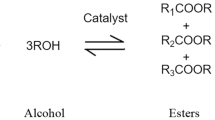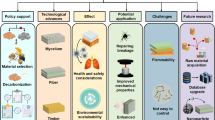Abstract
Quality initiatives such as ISO 9001 require reference values for laboratory measurements. There are no certified reference materials for the secondary material property of thermal effusivity. Reference values are derived from measurements of thermal conductivity, specific heat capacity, and density. A search of the literature is conducted to find materials with the “best’ values for thermal conductivity, specific heat capacity, and density so that a table of reference values for thermal effusivity may be obtained. Tabulated thermal effusivity values range from 0.04 kW s1/2 m−2 K−1 for expanded polystyrene board to 40 kW s1/2 m−2 K−1 for copper metal.
Similar content being viewed by others
References
WK43689. Method for thermal effusivity using the modified transient plane source method. Annual Book of ASTM Standards, vol 14.05. West Conshohocken: ASTM International.
Marin E. Teaching thermal physics by touching. Lat Am J Phys Edu. 2008;2(1):15–7.
Wongsriruksa S, Howes P, Conreen M, Miodownik M. The use of physical property data to predict the touch perception of material. Mater Des. 2012;42:238–44.
D7984. Method for measurement of thermal effusivity of fabrics using a guarded modified transient plan source instrument. Annual Book of ASTM Standards, vol 07.01. West Conshohocken.
Schneider AM, Holcombe BV. Properties influencing coolness to the touch of fabrics. Text Res J. 1991;61(8):488–94.
Businer JA, Buettner KJK. Thermal contact coefficient. J Metrol. 1961;18(3):422.
Wu YC. Material properties criteria for thermal safety. J Mater. 1972;7(4):573–9.
WK50791. Method for thermal effusivity calibration of the modified transient plane source apparatus. Annual Book of ASTM Standards, vol 14.05. West Conshohocken: ASTM International.
Skoog DA, West DM, Holler FJ, Crouch SR. Standard deviation of calculated results. Fundamentals of analytical chemistry. 8th ed. Grove: Thomson Brooks Cole; 2004. p. 127–33.
Tye RP, Salmon DR. Thermal conductivity certified reference materials: Pyrex 7740 and polymethymethacrylate. In: Dinwiddie RB, Mannello R, editors. Thermal conductivity 26—thermal expansion 14. Lancaster: DEStech Publications; 2005. p. 437–51.
Tye RP, Salmon DR. Development of new thermal conductivity reference materials: a summary of recent contributions by National Physical Laboratory. In: Wang H, Porter WD, Worley G, editors. Thermal conductivity 27—thermal expansion 15. Lancaster: DEStech Publication; 2005. p. 372–81.
Salmon D, Roebben G, Lamberty A, Brandt R. Certification of thermal conductivity and thermal diffusivity up to 1025 K of a glass-ceramic reference material BCR-724. In: Centre JR, editor. Brussels: European Commission; 2007.
Salmon DR, Brandt R, Tye RP. Pyroceram 9606, A certified ceramic reference material for high-temperature thermal transport properties: part 2—certification measurements. Int J Thermophys. 2010;31:355–73.
Clark J, Tye R. Thermophysical properties reference data for some key engineering alloys. High Temp High Press. 2004;35(36):1–14.
Blumm J, Lindemann A, Niedrig B. Measurement of the thermophysical properties of an NPL thermal conductivity standard Inconel 600. High Temp High Press. 2003/2007;35/36:621–6.
E691. Practice for conducting an interlaboratory study to determine the precision of a test method. Annual Book of ASTM Standards, vol 14.05. West Conshohocken: ASTM International (ASTM).
Moore JP, McElroy DL, Graves RS. Thermal conductivity and electrical resistivity of high-purity copper from 78 to 400 K. Can J Phys. 1967;45:3849–65.
White GK, Collocott SJ. Heat capacity of reference materials: Cu and W. J Phys Chem Ref Data. 1984;14(4):1251–7.
Anonymous. MatWeb. Accessed 8 Sept 2015.
E1225. Method for thermal conductivity of solids using the guarded-comparative-logitudinal heat flow technique. Annual Book of ASTM Standards. West Conshohocken: ASTM International.
E1269. Method for determining specific heat capacity by differential scanning calorimetry. Annual Book of ASTM Standards, vol 14.02. West Conshohocken: ASTM International.
B703. Method for apparent density of metal powders and related compounds using the Arnold meter. Annual Book of ASTM Standards.
Hurst JG, Giarratanno PJ. Certificate standard reference material 730 thermal conductivity—Tungsten. In: Standards NBo, editor. Washington: National Insitute of Standards and Technology; 1976.
Hurst JG, Lankford AB. Report of investigation research materials 8420 and 8421 Electrolytic iron thermal conductivity and electrical resistivity as a function of temperature from 2 to 1000 K In: Standards NBo, editor. Gaithersburg: National Insitute of Standards and Technology; 1984.
Desai RD. Thermodynamic properties of iron and silicon. J Phys Chem Ref Data. 1986;15(3):967–83.
Hulstrom LC, Tye RP, Smith SE. Round-robin testing of thermal conductivity reference materials. In: Yarbrough DW, editor. Thermal conductivity 19. New York: Plenum Press; 1986.
Salmon DR, Tye RP. Pyroceram 9606: a certified ceramic reference material for high-temperature thermal transport properties: part 1—material selection and characterization. Int J Thermophys. 2010;31:338–54. https://doi.org/10.1007/s10765-010-0709-9.
Jacobs-Fedore RA, Stroe DE. Thermophysical properties of Vespel(tm) SP1. In: Wang H, Porter WD, Worley G, editors. Thermal conductivity 27/thermal expansion 15. Lancaster: DEStech Publications; 2005. p. 231–2238.
Gaur U, Wunderlich B. Heat capacity and other thermodynamic properties of linear macromolecules. J Phys Chem Ref Data. 1982;11(2):313–25.
Zarr RR, Pinter AL. SRM 1453, expanded polystyrene board, for thermal conductivity form 281 K to 313 K. In: Technology NIoSa, editor. Gaithersburg: National Insitute of Standards and Technology; 2012.
Bateman R, editor. Criterion and need for a standard for thermal effusivity measurements. In: 43rd Conference of the North American Thermal Analysis Society, Montreal; 2015.
Author information
Authors and Affiliations
Corresponding author
Rights and permissions
About this article
Cite this article
Blaine, R.L. In search of thermal effusivity reference materials. J Therm Anal Calorim 132, 1419–1422 (2018). https://doi.org/10.1007/s10973-018-7020-6
Received:
Accepted:
Published:
Issue Date:
DOI: https://doi.org/10.1007/s10973-018-7020-6




